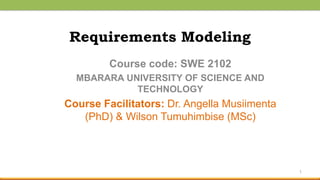Requirements modeling involves creating models during requirements analysis to understand current systems or business processes being automated and how users will interact with a new system. It helps with elicitation, validation, and communication of requirements. Common tools for requirements modeling include use cases, state diagrams, UI mockups, storyboards, and prototypes.
Define requirements modeling as representing the customers' needs and the problem domain using models to facilitate understanding between stakeholders.
Explain four roles of requirements modeling as:
1) Guiding elicitation by helping determine questions to ask and uncover hidden requirements
2) Providing progress measures by ensuring model completeness indicates elicitation is complete
3) Hel









































